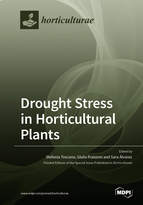Drought Stress in Horticultural Plants
A special issue of Horticulturae (ISSN 2311-7524). This special issue belongs to the section "Biotic and Abiotic Stress".
Deadline for manuscript submissions: closed (30 June 2022) | Viewed by 61192
Special Issue Editors
Interests: ornamental plants; abiotic stresses; antioxidant enzymes; biodiversity; product quality; germination; light response
Special Issues, Collections and Topics in MDPI journals
Interests: plant physiology; abiotic stresses; fruit quality; postharvest physiology; vegetable production; biostimulant; sustainable agriculture
Interests: deficit irrigation; plant physiology; ornamental plants; stress physiology; evapotranspiration; salinity; water relations; tree nut crops; intrinsic water use efficiency
Special Issues, Collections and Topics in MDPI journals
Special Issue Information
Dear Colleagues,
Drought stress is one of the main factors limiting horticultural crops, especially in environments like the Mediterranean basin, which is often characterized by sub-optimal water availability. The global change will determine the increase of semi-arid conditions, so all horticultural crops will have to cope with the water scarcity. Appropriate plant selection and new cultivation methods, especially methods of deficit irrigation, are crucial in improving the crop cultivation performances.
Horticultural plants can have specific adaptive mechanisms to overcome the negative effects of drought stress. Drought-tolerant plants show different adjustment mechanisms to overcome this stress, including morphological, physiological, and biochemical modifications. The plant responses include increasing the root/shoot ratio, growth reduction, leaf anatomy change, reduction of leaf size, and reduction of total leaf area to limit the water loss and guarantee the photosynthesis process. Furthermore, drought stress influences gas exchange and other physiological parameters. Recent acquisitions on the mechanism of signal transduction and the development of drought tolerance in plants are useful to understand the action mechanisms.
In this context, this Special Issue aims to collect original and quantitative studies focusing on the effects of drought stress on horticultural plants. Studies conducted on different crops in open fields or in controlled environments are welcome. Particular attention will be paid to the analysis of the response mechanisms to drought stress.
Dr. Stefania Toscano
Dr. Giulia Franzoni
Dr. Sara Álvarez
Guest Editors
Manuscript Submission Information
Manuscripts should be submitted online at www.mdpi.com by registering and logging in to this website. Once you are registered, click here to go to the submission form. Manuscripts can be submitted until the deadline. All submissions that pass pre-check are peer-reviewed. Accepted papers will be published continuously in the journal (as soon as accepted) and will be listed together on the special issue website. Research articles, review articles as well as short communications are invited. For planned papers, a title and short abstract (about 100 words) can be sent to the Editorial Office for announcement on this website.
Submitted manuscripts should not have been published previously, nor be under consideration for publication elsewhere (except conference proceedings papers). All manuscripts are thoroughly refereed through a single-blind peer-review process. A guide for authors and other relevant information for submission of manuscripts is available on the Instructions for Authors page. Horticulturae is an international peer-reviewed open access monthly journal published by MDPI.
Please visit the Instructions for Authors page before submitting a manuscript. The Article Processing Charge (APC) for publication in this open access journal is 2200 CHF (Swiss Francs). Submitted papers should be well formatted and use good English. Authors may use MDPI's English editing service prior to publication or during author revisions.
Keywords
- drought
- plant physiology
- adaptive mechanism
- water use efficiency
- oxidative stress
- signal transduction








